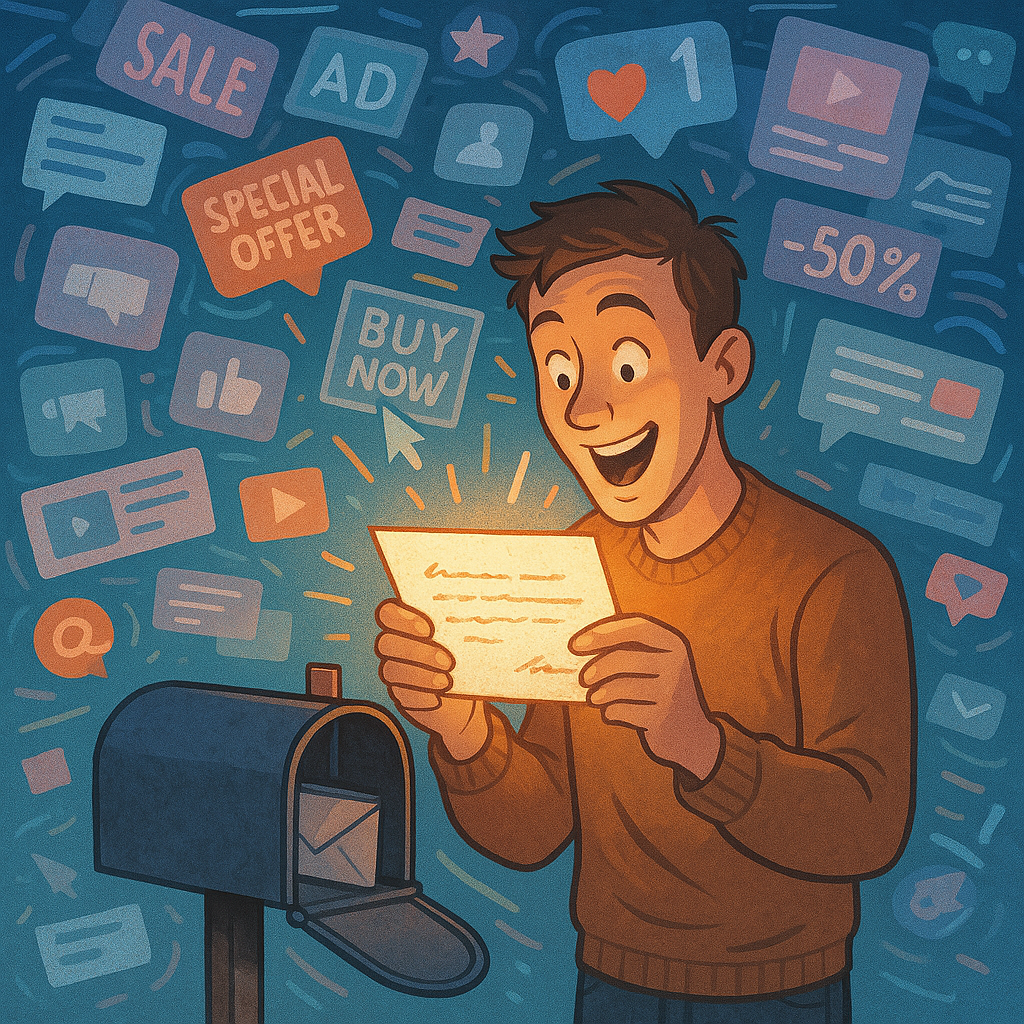Let’s talk about something a bit mind-blowing.
The average person is bombarded with 4,000-10,000 ad messages DAILY.
That’s not a typo. Four THOUSAND to TEN thousand.
It’s a mind-blowing stat from the American Marketing Association, and a 500% increase from just ten years ago.
We’re Swimming in Advertising
Think about where all these messages come from:
- Your phone (social feeds, apps, notifications)
- Laptop screens (websites, emails, banners)
- Physical spaces (billboards, store signage, product packaging)
- Everything you listen to (radio, podcasts, voice assistants)
And we wonder why 71% of consumers report feeling “bombarded” and 82% have developed what psychologists call “advertising fatigue syndrome.” (Yes, that’s a real thing now.)
Your Brain on Ad Overload
Here’s what fascinates me about our adaptation to this onslaught:
Our brains have gotten REALLY good at filtering. The Nielsen Norman Group found that 86% of us have developed “banner blindness” – we literally don’t see digital ads anymore.
Marketing experts tell me clients now need to see a digital ad 7-8 times before it registers – that’s double what it took in previous decades.
The cost of getting attention has skyrocketed.
The Remarkable Scarcity of Handwritten Notes
Against this backdrop of digital chaos, here’s a stat that stopped me in my tracks:
The average American receives just 10 personal handwritten notes or letters per year.
For many, that number is even lower.
First-class mail volume has plummeted by more than 45% since 2000. The typical household now receives one personal letter every seven weeks.
This creates an opportunity that most businesses completely miss.
Why Your Brain Lights Up for Handwritten Notes
I was talking with a neuroscience researcher friend last week, and she shared something fascinating from Temple University:
Physical mail activates entirely different brain centers than digital communications:
- It stimulates the ventral striatum (associated with value and desirability)
- Creates 20% stronger emotional response
- Generates 30% higher brand recall
- Recipients spend 118% longer looking at physical mail
When that physical mail is handwritten? These effects go through the roof.
The Secret Weapon in a Digital World
So why do handwritten notes cut through when everything else gets filtered?
- Pattern disruption – In a sea of sameness, handwriting immediately signals “different” to your brain.
- Effort recognition – We instinctively understand someone invested time to create this message.
- Tactile engagement – The physical interaction creates multisensory involvement missing from digital.
- Scarcity value – Basic economics: rare things become inherently more valuable.
- Trust signaling – The subtle imperfections in handwriting communicate authenticity that perfect typography can’t match.
The Numbers Don’t Lie
I recently tested this with a client campaign, and the results were staggering:
- Open rates: While email open rates hover around 20%, handwritten envelopes hit 99%
- Response rates: Direct mail generates a 4.4% response, but handwritten direct mail pushed to 8.7%
- Customer retention: People who received handwritten communication showed 37% higher retention over a three-year period
This isn’t just theory – it’s measurable impact.
Finding Balance in a Digital-First World
Look, I’m not suggesting abandoning digital – that would be crazy in 2025.
But the smartest companies I work with are creating what we call “high-low communication mixes” – using automation for frequency and reach while incorporating high-touch handwritten communication at critical moments.
In a world where human attention has become the scarcest resource, perhaps the most effective way to signal that you truly value someone’s attention is to demonstrate that you’ve invested your own attention first.
So here’s my question: When was the last time YOU sent a handwritten note to a customer? And what happened?
And are you ready to kickstart your advertising with robotic handwritten cards and letters?

